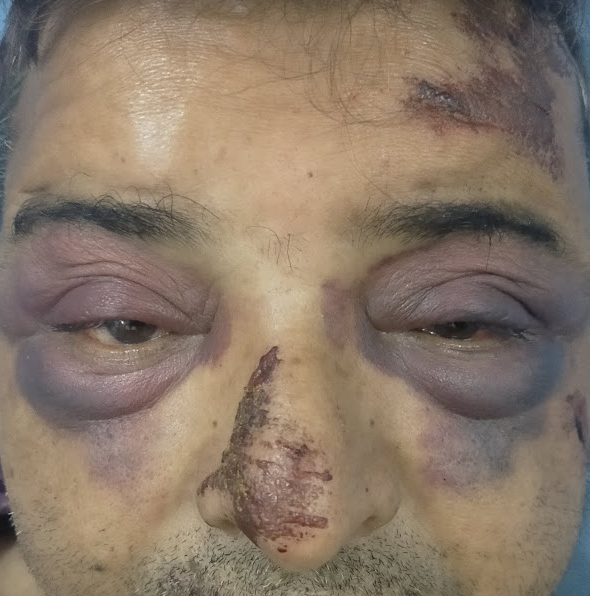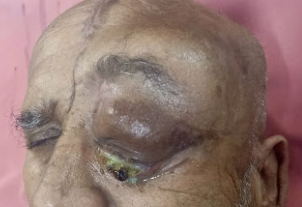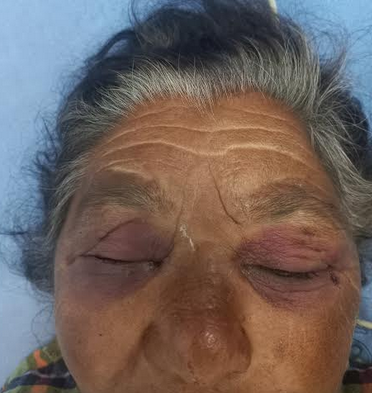[1]
Timmerman R. Images in clinical medicine. Raccoon eyes and neuroblastoma. The New England journal of medicine. 2003 Jul 24:349(4):e4
[PubMed PMID: 12878754]
[2]
Solai CA, Domingues CA, Nogueira LS, de Sousa RMC. Clinical Signs of Basilar Skull Fracture and Their Predictive Value in Diagnosis of This Injury. Journal of trauma nursing : the official journal of the Society of Trauma Nurses. 2018 Sep/Oct:25(5):301-306. doi: 10.1097/JTN.0000000000000392. Epub
[PubMed PMID: 30216260]
[3]
McPheeters RA, White S, Winter A. Raccoon eyes. The western journal of emergency medicine. 2010 Feb:11(1):97
[PubMed PMID: 20411091]
[4]
Herbella FA, Mudo M, Delmonti C, Braga FM, Del Grande JC. 'Raccoon eyes' (periorbital haematoma) as a sign of skull base fracture. Injury. 2001 Dec:32(10):745-7
[PubMed PMID: 11754879]
[5]
Satyarthee GD, Sharma BS. Posttraumatic orbital emphysema in a 7-year-old girl associated with bilateral raccoon eyes: Revisit of rare clinical emergency, with potential for rapid visual deterioration. Journal of pediatric neurosciences. 2015 Apr-Jun:10(2):166-8. doi: 10.4103/1817-1745.159199. Epub
[PubMed PMID: 26167226]
[6]
Aalbers M, van Dijk JMC. Teaching NeuroImages: Raccoon eye in subarachnoid hemorrhage. Neurology. 2019 Mar 26:92(13):e1534-e1535. doi: 10.1212/WNL.0000000000007180. Epub
[PubMed PMID: 30910950]
[7]
DeBroff BM, Spierings EL. Migraine associated with periorbital ecchymosis. Headache. 1990 Apr:30(5):260-3
[PubMed PMID: 2354948]
[8]
Chuang Yu, Chiu CH, Wong KS, Huang JG, Huang YC, Chang LY, Lin TY. Severe adenovirus infection in children. Journal of microbiology, immunology, and infection = Wei mian yu gan ran za zhi. 2003 Mar:36(1):37-40
[PubMed PMID: 12741731]
[9]
Mehta AA, Wagner LH, Blace N. Spontaneous upper eyelid ecchymosis: A rare presenting sign for frontal sinus mucocele. Orbit (Amsterdam, Netherlands). 2017 Jun:36(3):183-187. doi: 10.1080/01676830.2017.1280058. Epub 2017 Mar 10
[PubMed PMID: 28282265]
[10]
Wisuthsarewong W, Soongswang J, Chantorn R. Neonatal lupus erythematosus: clinical character, investigation, and outcome. Pediatric dermatology. 2011 Mar-Apr:28(2):115-21. doi: 10.1111/j.1525-1470.2011.01300.x. Epub 2011 Mar 1
[PubMed PMID: 21362029]
[11]
Matsuura H, Anzai Y, Kuninaga N, Maeda T. Raccoon Eye Appearance: Amyloidosis. The American journal of medicine. 2018 Jul:131(7):e305. doi: 10.1016/j.amjmed.2018.02.009. Epub 2018 Mar 14
[PubMed PMID: 29550357]
[12]
de Moura CG, Cruz CM, de Souza SP. Raccoon sign. Arthritis and rheumatism. 2013 Mar:65(3):692. doi: 10.1002/art.37793. Epub
[PubMed PMID: 23203502]
[13]
Liu YT, Yang MH, Cao LZ, Huang YH, Xie M, Yang LC, Yang H, Tang X. [Painless skin nodules and ecchymosis in a school-aged girl]. Zhongguo dang dai er ke za zhi = Chinese journal of contemporary pediatrics. 2015 Oct:17(10):1131-6
[PubMed PMID: 26483238]
[14]
Inokuchi R, Tagami S, Maehara H. An elderly woman with bilateral raccoon eyes. Emergency medicine journal : EMJ. 2016 Nov:33(11):781. doi: 10.1136/emermed-2015-205071. Epub
[PubMed PMID: 28319930]
[15]
Weingarten TN, Hall BA, Richardson BF, Hofer RE, Sprung J. Periorbital ecchymoses during general anesthesia in a patient with primary amyloidosis: a harbinger for bleeding? Anesthesia and analgesia. 2007 Dec:105(6):1561-3, table of contents
[PubMed PMID: 18042847]
[16]
Nasiri J, Zamani F. Periorbital Ecchymosis (Raccoon Eye) and Orbital Hematoma following Endoscopic Retrograde Cholangiopancreatography. Case reports in gastroenterology. 2017 Jan-Apr:11(1):134-141. doi: 10.1159/000456657. Epub 2017 Mar 17
[PubMed PMID: 28611566]
Level 3 (low-level) evidence



